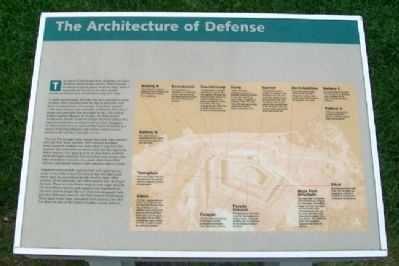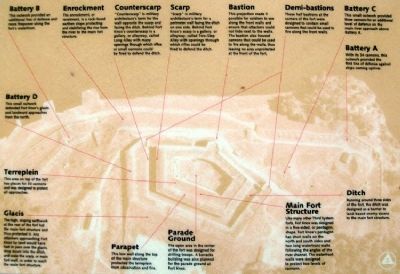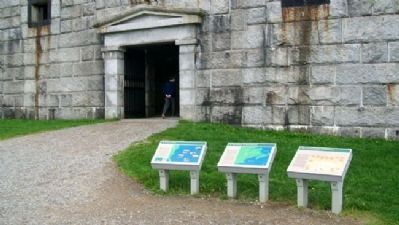Prospect in Waldo County, Maine — The American Northeast (New England)
The Architecture of Defense
The nation's Third System forts, including Fort Knox, all shared similar design features. These features combined to guard against attack by ships, make it impossible for the fort to be taken quickly, [and] provide protection from a land-based, long-term siege.
To fulfill these purposes, forts like Fort Knox provided a variety of places where cannons could fire and be protected. Fort Knox was planned for 135 cannons. With these cannons in the main structure and outworks, or batteries, Fort Knox's design used principles first developed by the 17th century French engineer Marquis de Vauban. He believed that fortifications should consist of multiple layers of defenses that attackers would have to conquer one at a time. Designers of Third System forts envisioned these layers of defense as a means of delaying attackers until outside reinforcements arrived or the attackers' strength ran out.
The Civil War brought many changes that made large masonry forts like Fort Knox obsolete. New armored and faster steam-powered warships were more elusive targets for fort cannons. The armaments on these vessels had also improved. Rifled cannons, with spiral grooves in their bores, could fire newly-developed projectiles with more force and accuracy than older smoothbore cannons. As a result, shots from rifled cannons could quickly reduce a fort's masonry walls to rubble.
Engineers unsuccessfully experimented with applying iron armor to walls of masonry forts so that the walls could better repel the powerful projectiles fired by ships' rifled cannons. At the same time, new rifled cannons were developed for forts. These new land-based weapons were larger than the old smoothbore cannons and required new emplacements. The new cannons meant that new forts were designed, built, and sited differently than the old Third System fortifications. Never again would large, beautifully-built masonry forts like Fort Knox be part of the nation's modern coastal defenses.
Erected by Maine Department of Conservation.
Topics. This historical marker is listed in these topic lists: Architecture • Forts and Castles.
Location. 44° 33.984′ N, 68° 48.126′ W. Marker is in Prospect, Maine, in Waldo County. Marker is at the entrance to the fort, at Fort Knox State Historic Site. Touch for map. Marker is at or near this postal address: 711 Fort Knox Road (Maine Route 174), Stockton Springs ME 04981, United States of America. Touch for directions.
Other nearby markers. At least 8 other markers are within walking distance of this marker. A Grand Plan (here, next to this marker); A Question of Boundaries (here, next to this marker); Fort Knox (a few steps from this marker); Where Did the Soldiers Sleep? (within shouting distance of this marker); The Heart of the Fort (within shouting distance of this marker); Digging Down and Building Up (within shouting distance of this marker); The Casemate - Key to Fort Design (within shouting distance of this marker); Firing a Cannon (within shouting distance of this marker). Touch for a list and map of all markers in Prospect.
Also see . . .
1. Star Fort. Wikipedia entry (Submitted on May 7, 2012, by William Fischer, Jr. of Scranton, Pennsylvania.)
2. Fort Pulaski National Monument. National Park Service website entry (Submitted on May 7, 2012, by William Fischer, Jr. of Scranton, Pennsylvania.)
3. Fort Knox State Historic Site, Maine guide PDF. Maine.gov website entry (Submitted on May 7, 2012, by William Fischer, Jr. of Scranton, Pennsylvania.)
4. Sébastien Le Prestre de Vauban. Wikipedia entry (Submitted on October 9, 2021, by Larry Gertner of New York, New York.)
Credits. This page was last revised on October 9, 2021. It was originally submitted on May 7, 2012, by William Fischer, Jr. of Scranton, Pennsylvania. This page has been viewed 572 times since then and 9 times this year. Photos: 1, 2, 3. submitted on May 7, 2012, by William Fischer, Jr. of Scranton, Pennsylvania.


